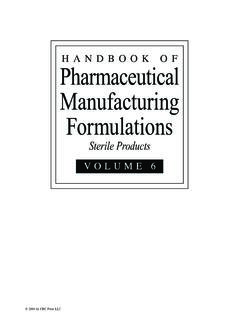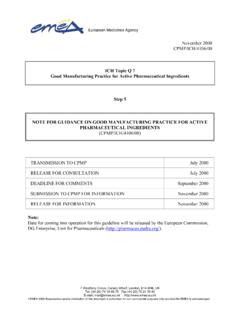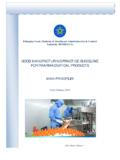Transcription of Annex 6 WHO good manufacturing practices for sterile ...
1 261 World Health OrganizationWHO Technical Report Series, No. 961, 2011 Annex 6 WHO good manufacturing practices for sterile pharmaceutical products IntroductionFollowing implementation of these WHO good manufacturing practices (GMP) guidelines (1) within the context of the WHO Prequalifi cation of Medicines Programme, clarifying, editorial modifi cations have been proposed. These changes were adopted for maintenance purposes. In order to ease reading the full guideline has been reproduced again as an Annex to the current report of the WHO Expert Committee on Specifi cations for pharmaceutical Preparations.
2 WHO good manufacturing practices for sterile pharmaceutical products 1. General considerations 2. Quality control 3. Sanitation 4. Manufacture of sterile preparations 5. Sterilization 6. Te r minal sterilization 7. aseptic processing and sterilization by fi ltration 8. Isolator technology 9. Blow/fi ll/seal technology10. Personnel11. Premises12. Equipment13. Finishing of sterile productsReferencesFurther reading2621. General The production of sterile preparations should be carried out in clean areas, entry to which should be through airlocks for personnel and/or for equipment and materials.
3 Clean areas should be maintained to an appropriate standard of cleanliness and supplied with air that has passed through fi lters of the required effi The various operations of component preparation (such as those involving containers and closures), product preparation, fi lling and sterilization should be carried out in separate areas within the clean area. These areas are classifi ed into four grades (see section 4). manufacturing operations are divided here into two categories: fi rst, those where the product is terminally sterilized; and second, those which are conducted aseptically at some or all Quality The sterility test applied to the fi nished product should only be regarded as the last in a series of control measures by which sterility is assured.
4 The test should be validated for the product (s) Samples taken for sterility testing should be representative of the whole of the batch but should, in particular, include samples taken from parts of the batch considered to be most at risk of contamination, for example: for products that have been fi lled aseptically, samples should include containers fi lled at the beginning and end of the batch and after any signifi cant interruption of work; for products that have been heat sterilized in their fi nal containers, consideration should be given to taking samples from that part of the load that is potentially the The sterility of the fi nished product is assured by validation of the sterilization cycle in the case of terminally sterilized products, and by media simulation or media fi ll runs for aseptically processed products.
5 Batch-processing records and, in the case of aseptic processing, environmental quality records, should be examined in conjunction with the results of the sterility tests. The sterility test procedure should be validated for a given product . Pharmacopoeial methods should be used for the validation and performance of the sterility test. In those cases where parametric release has been authorized in place of sterility testing special attention should be paid to the validation and the monitoring of the entire manufacturing For injectable products the water for injection and the intermediate, if appropriate, and fi nished products should be monitored for endotoxins, using an established pharmacopoeial method that has been validated for each type of product .
6 For large-volume infusion solutions, such monitoring of water or intermediates should always be done, in addition to any tests required by an approved monograph for the fi nished product . When a sample fails a test, the cause of the failure should be investigated and necessary action should be taken. Alternative methods to those in the pharmacopoeias may be used if they are validated, justifi ed and The use of rapid microbiological methods to replace the traditional microbiological methods, and to obtain earlier results on the microbiological quality of, for example, water, the environment or bioburden, could be considered if appropriately validated and if a comparative assessment of the proposed rapid method is performed against the pharmacopoeial The sanitation of clean areas is particularly important.
7 They should be cleaned frequently and thoroughly in accordance with an approved written programme. Where disinfectants are used, more than one type should be employed. Monitoring should be regularly undertaken to detect contamination or the presence of an organism against which the cleaning procedure is ineffective. Interactions between different cleaning materials should be validated. Appropriate cleaning validation should be carried out to ensure disinfectant residuals can be detected and are removed by the cleaning Disinfectants and detergents should be monitored for microbial contamination; dilutions should be kept in previously cleaned containers and should only be stored for defi ned periods unless sterilized.
8 Disinfectants and detergents used in Grade A and B areas should be sterile before A disinfectant programme should also include a sporicidal agent since many common disinfectants are ineffective against spores. The effectiveness of cleaning and disinfectant procedures should be Fumigation of clean areas may be useful for reducing microbial contamination in inaccessible Manufacture of sterile Clean areas for the manufacture of sterile products are classifi ed according to the required characteristics of the environment. Eac h manufacturing operation requires an appropriate level of environmental 264cleanliness in the operational state to minimize the risks of particulate or microbial contamination of the product or materials being Detailed information on methods for determining the microbiological and particulate cleanliness of air, surfaces, etc.
9 , is not given in these 14644-1 (2) should be used for classifi cation of cleanliness according to concentration of airborne particles (determination of number of sample locations, calculation of sample size and evaluation of classifi cation from the data obtained). Table 1 should also be used to defi ne the levels to be used as the basis for monitoring clean areas for airborne For the manufacture of sterile pharmaceutical preparations, four grades of clean areas are distinguished as follows: Grade A: The local zone for high-risk operations, fi lling and making aseptic connections.
10 Normally such conditions are achieved by using a unidirectional airfl ow workstation. Unidirectional airfl ow systems should provide a homogeneous air speed of m/s (guidance value) at a defi ned test position 15 30 cm below the terminal fi lter or air distributor system. The velocity at working level should not be less than m/s. The uniformity and effectiveness of the unidirectional airfl ow should be demonstrated by undertaking airfl ow visualization tests. Grade B: In aseptic preparation and fi lling, this is the background environment for the Grade A zone. Grades C and D: Clean areas for carrying out less critical stages in the manufacture of sterile products or carrying out activities during which the product is not directly exposed ( aseptic connection with aseptic connectors and operations in a closed system).














